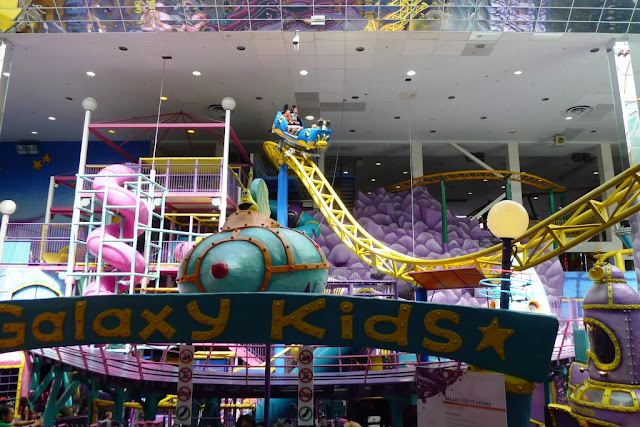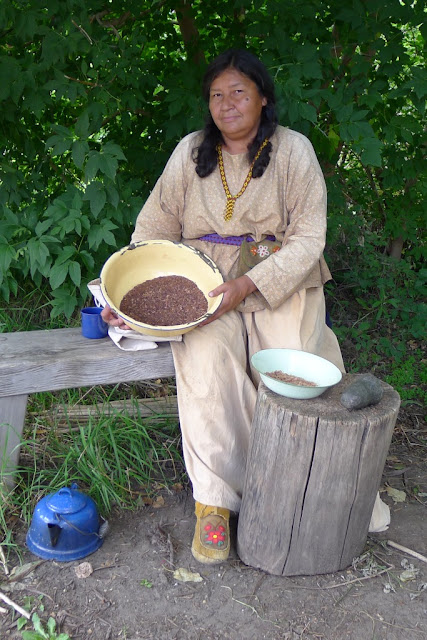Newsletter 10 - August 2013
Edmonton (area
population just over a million) is the capital of Alberta, a lovely city with
the Saskatchewan River dividing the downtown and Government buildings on the
north side,
 |
| Edmonton skyline |
 |
| Jen and Garry with Lauren and Matt |
and she insisted we meet her and her family, which we did. We had a
lovely time with them, being shown the city and surrounds by Fran and Nick,
 |
| Fran and Nick with Garry and Jen |
while
the RV had a service, and enjoying a BBQ that evening in their home with
homemade Saskatoon Pie. The small dark coloured berries are a little like small
blueberries and they’re ready for picking right now.
The city is
set out on a grid with streets going North South and avenues going East West-
unusual to us at first but very ordered and easy to find your way around after
using it a few times. We had a stroll around Churchill Square,
 |
| Churchill Square |
 |
| Clock tower and Carillon in Churchill Square |
visited the new
building for the Art Gallery
 |
| Art Gallery |
and then we all went to see Rutherford House,
built for the first Premier of Alberta in 1907.
 |
| Rutherford House |
The West
Edmonton Mall has been the largest shopping mall in the world from 1981 to 2004
under the one roof. Now it is the fifth largest (most of the larger ones are in
China). It is unbelievable, with over 800 stores and services, 100 food
outlets, parking for 20,000 vehicles and attracting between 60,000 – 150,000
shoppers daily.
 |
| West Edmonton Mall - Galaxyland |
Besides the shopping there are many attractions. Galaxyland
Amusement Park, (it used to be Fantasyland until the Disney Corporation took
them to court,) has 24 rides and play areas
 |
| Loop the loop |
 |
| Roller Coasters |
All the rides were packed into an area with just
enough room for us to walk between.
 |
| Twirly Roller Coaster |
There is
also a Water park with the world’s largest indoor wave pool
 |
| Wave Pool |
plus ten water slides
and other water play features.
 |
| Water slides |
People were sunning themselves on plastic
“lazyboys” under the clear perspex roof while lots of people were bobbing in
the waves on large rubber rings.
 |
| Indoor Ice Rink |
With school
holidays there were kids skating on the full sized hockey rink and other people everywhere enjoying the attractions. For more
info, Google Wikipedia-(West Edmonton Mall).
Fort
Edmonton could be called an historical adventure park where four periods of
time of Edmonton’s early history are displayed.
You are able to catch a train
to the fort that was set up as a fur trading post in the mid 1800’s,
then walk
to the street that shows how the settlement began in the late 1800’s with
simple homes and businesses.
The early 1900’s has a street car rattling down the main
street.
Now more sophisticated houses with electric light and bathrooms, post
and telephone offices, banks, a penny arcade and the fire hall are all there to
explore.
The modern era of the 1920’s has the theatre,
drug store, air hanger
and motordrome (the car repair and maintenance business).
Many people are in
costume and tell you their stories of the time they represent. We really
enjoyed the park.
 |
| The train runs around the park |
 |
| Indian Camp |
 |
| Pemmican is a mixture of ground dried buffalo meat, saskatoon berries and rendered buffalo fat made into patties - great travelling food. |
 |
| Fort Edmonton trader's house |
 |
| Fort Edmonton - The walls was not for defense against Indians but to stop wild animals, like wolves, from stealing the furs stored inside. |
 |
| A Gun for 10 beaver pelts |
 |
| Skin Press |
 |
| 1850's settlement |
 |
| 1850's transport |
 |
| Early Street Car |
 |
| The first house built in Edmonton by the Rutherfords |
 |
| Capitol Theatre 1920s |
 |
| Motordrome Garage |
 |
| 1920's Farmhouse and barn |
 |
| Ukrainian Village |
 |
| Ukrainian Village buildings |
 |
| Herb garden |
 |
| House and garden |
 |
| St Vladimir's Church |
 |
| St Vladimir's Church interior |
 |
| Cutting the grass around the church with a horse drawn mower |
 |
| The farmer with his team |
 |
| Grain Elevator |
 |
| The sod house |
 |
| Interior of the sod house |
 |
| A great way to get around the village |
 |
| Worlds biggest Pysanka (Ukrainian decorated egg) at Vegreville. It is also a wind vane |
 |
| Even the sides of the road are baled |
 |
| Canola and oil |
 |
| Saskatchewan grain elevator |
 |
| Old grain elevators |
 |
| Fort Battleford |
 |
| Fort Battleford interior |
 |
| Fort Battleford houses |
 |
| A wet day in Moose Jaw |
 |
| Moose Jaw tunnel adventure ticket office |
 |
| Moose Jaw main street |
 |
| Moose Jaw "wedding cake" house |
 |
| Great crops on the prairies |
We were near
the border when the oil and gas wells started to appear in the fields, and when
we were well into the States the development was unbelievable.
Small jack pumps
became big ones and villages became mobile towns with flattened fields, gravel
spread and transportable homes lined up, hundreds of them.
New roads had been
bulldozed through canola fields to pump sites and drilling rigs.
All this
sudden development and job opportunities has brought many people from across
the States. The road works and widening of rural roads have brought those
workers, and the electricity industry has their workers too, moving poles and
putting up new transmission towers.
The lady at the salon where I had a hair
cut had five men in front of me and said the population of Williston had grown
from 10.000 three years ago to 40.000 now, and growing.
Rent was expensive
because of the scarceness of accommodation and many men were living in mobile homes
and commuting home each break.
 |
| Diversification from hay to oil |
 |
| Worker accommodation |
 |
| A hive of activity |
 |
| Road building on the move |
 |
| It would appear that the road builder's program did not line up with the electricity utility and one of the poles fell over and they had to get a bucket in to hold up the wires |
 |
| Roosevelt NP |
 |
| More traffic stoppers |
 |
| A great example of the different strata laid down over time |
 |
| Plenty of buffalo |
 |
| Prairie Dog |

No comments:
Post a Comment